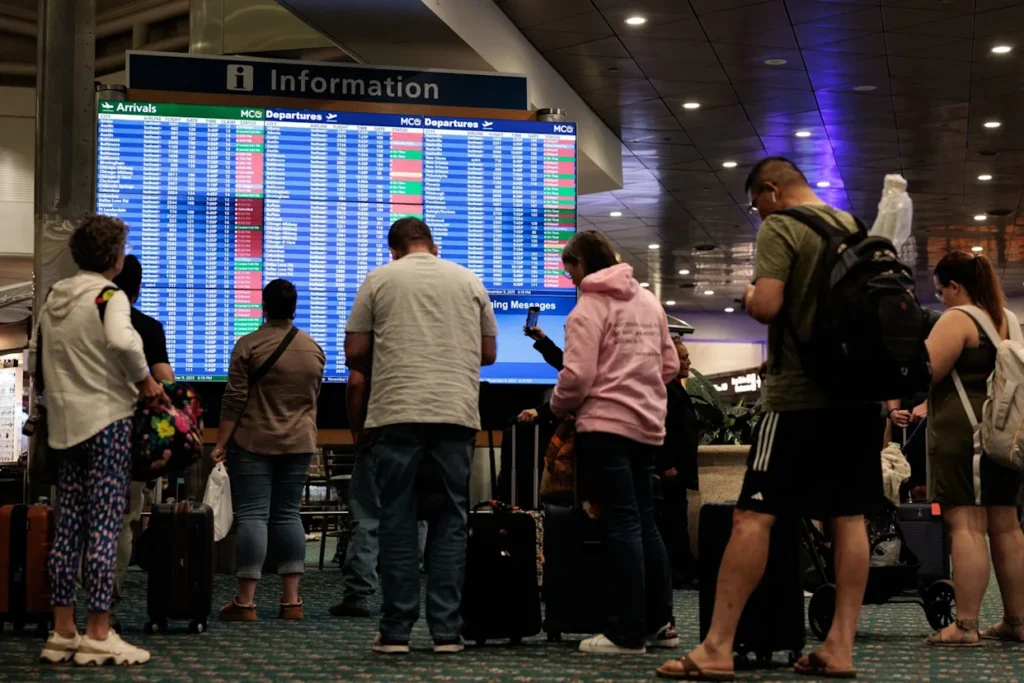As the government shutdown looms toward its end, U.S. air travelers face the reality that airport operations may not immediately return to normal. The airline industry is warning that even after federal employees return to work, disruptions at airports could persist for several days, affecting flights, security screenings, and overall travel schedules.
Delayed Recovery Beyond the Shutdown
Airlines and airport authorities stress that the resumption of normal operations is not instantaneous. Even once a shutdown concludes, the backlog of delayed flights, understaffed security checkpoints, and processing of passengers could take several days to clear.
The airlines’ trade association has urged travelers to prepare for extended wait times, missed connections, and changes in flight schedules. They emphasize that while government employees will resume their duties, the volume of passengers returning to airports may temporarily overwhelm staff and infrastructure.
Factors Slowing the Return to Normal
Several factors contribute to the slow recovery:
- Staffing Gaps
Federal shutdowns result in furloughs for Transportation Security Administration (TSA) personnel, air traffic controllers, and other critical airport staff. Even after reopening, employees may need time to return to work, undergo briefings, and resume normal operational flow. - Backlog of Flights
Flights delayed or canceled during the shutdown create a ripple effect that can extend for days. Airlines must reschedule aircraft, crews, and gate availability, which requires careful coordination across hubs and connecting flights. - Security Screening Delays
TSA checkpoints may experience congestion as staff return and passengers who postponed travel attempt to fly simultaneously. The combination of increased passenger volume and staff readjustment periods could lead to long lines and extended waiting times. - Operational Recalibration
Airports may need to recalibrate logistics such as baggage handling, customs processing, and air traffic control sequencing, particularly at major hubs where delays compound rapidly.
Airports Likely to Experience Delays
While disruptions may be felt nationwide, certain airports with high passenger volume or complex operations are expected to be affected more significantly. Delays are anticipated at:
- Hartsfield-Jackson Atlanta International Airport (ATL)
- Los Angeles International Airport (LAX)
- Chicago O’Hare International Airport (ORD)
- Dallas/Fort Worth International Airport (DFW)
- Denver International Airport (DEN)
- John F. Kennedy International Airport (JFK)
- San Francisco International Airport (SFO)
- Seattle-Tacoma International Airport (SEA)
These hubs, which typically handle tens of thousands of passengers daily, may see longer queues at TSA checkpoints and congestion on tarmacs, further complicating flight schedules. Regional airports may also face delays, especially for connecting flights affected by disruptions at major hubs.
Airline Recommendations for Travelers
Airlines and travel authorities are urging passengers to plan carefully and remain flexible:
- Check Flight Status Frequently: Passengers should monitor airlines’ apps, websites, and notifications for updates on delays or cancellations.
- Arrive Early: Travelers are advised to arrive at airports well in advance to accommodate potentially longer security lines.
- Be Flexible: Consider adjusting travel plans or booking alternative flights if possible.
- Prepare for Longer Lines: Packing efficiently, having travel documents ready, and understanding TSA procedures can help reduce delays.
- Stay Informed: Follow official announcements from airports and the TSA for real-time updates on staffing and checkpoint conditions.
The Broader Impact on the Aviation Industry
The government shutdown has highlighted vulnerabilities in the aviation system, particularly its reliance on federal employees. Airlines may face financial strain from delayed flights, crew overtime, and customer compensation for disruptions.
Moreover, extended delays can ripple across international flights, cargo operations, and airline logistics networks, further amplifying the impact of a shutdown. Analysts warn that while the U.S. aviation system is resilient, travelers should not expect an immediate return to smooth operations, even after federal offices reopen.
Conclusion
Although the end of the government shutdown will bring relief to federal employees and resume normal operations, the path back to fully functional airports will be gradual. Passengers should anticipate delays, remain patient, and plan for extended processing times.
Airlines and airport authorities urge travelers to recognize that recovery will take days, not hours, underscoring the lingering effects of even short-term disruptions in the highly interconnected U.S. air travel network.



